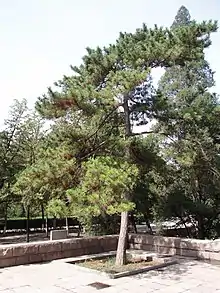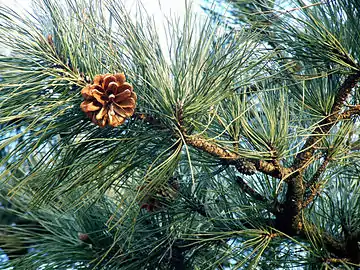| Pinus tabuliformis | |
|---|---|
 | |
| Scientific classification | |
| Kingdom: | Plantae |
| Clade: | Tracheophytes |
| Clade: | Gymnospermae |
| Division: | Pinophyta |
| Class: | Pinopsida |
| Order: | Pinales |
| Family: | Pinaceae |
| Genus: | Pinus |
| Subgenus: | P. subg. Pinus |
| Section: | P. sect. Pinus |
| Subsection: | P. subsect. Pinus |
| Species: | P. tabuliformis |
| Binomial name | |
| Pinus tabuliformis | |
Pinus tabuliformis, also called Chinese red pine,[1] Manchurian red pine,[2] or Southern Chinese pine[3] is a pine native to northern China and northern Korea.
Description
Pinus tabuliformis is a medium-sized evergreen tree growing to 20–30 metres (66–98 feet) tall, with a flat-topped crown when mature. The growth rate is fast when young, but slows with age. The grey-brown bark fissures at an early age compared to other trees. The broadly spreading shape is very pronounced, in part due to the long horizontal branching pattern.
The needle-like leaves are shiny grey-green, 10–17 centimetres (4–6+3⁄4 inches) long and 1.5 millimetres (1⁄16 in) broad, usually in pairs but occasionally in threes at the tips of strong shoots on young trees. The cones are green, ripening brown about 20 months after pollination, broad ovoid, 4–6 cm (1+5⁄8–2+3⁄8 in) long, with broad scales, each scale with a small prickle. The seeds are 6–7 mm (1⁄4–9⁄32 in) long with a 15–20 mm (9⁄16–13⁄16 in) wing, and are wind-dispersed.
Varieties
There are two varieties:
- Pinus tabuliformis var. tabuliformis. China, except for Liaoning. Broadest cone scales under 15 mm broad.
- Pinus tabuliformis var. mukdensis. Liaoning, North Korea. Broadest cone scales over 15 mm broad.
Some botanists also treat the closely related Henry's pine (Pinus henryi) and Sikang pine (Pinus densata) as varieties of Chinese red pine; in some older texts even the very distinct Yunnan pine (Pinus yunnanensis) is included as a variety.
Taxonomy
In some older texts the name is spelled "Pinus tabulaeformis".
The specific epithet, tabuliformis ('table-shaped'), refers to the species' flat-topped crown.
Distribution and habitat
The species can be found in northern China from Liaoning west to Inner Mongolia and Gansu, and south to Shandong, Henan and Shaanxi, as well as northern Korea.
Uses
The wood is used for general construction. The pulpwood produces certain resins that are used as artificial vanilla flavouring (vanillin). The resin is also used to make turpentine and related products, and is used medicinally to treat a variety respiratory and internal ailments, such as kidney and bladder upsets, wounds, and sores. The bark is a source of tannin. Medicinal use of the pine needles also takes place, which also contain a natural insecticide, as well as a source for a dye. The needles are used to brew pine needle tea (sollip-cha).[4]
Its cultivation is uncommon outside of China, grown only in botanical gardens.
References
- 1 2 Farjon, A. (2013). "Pinus tabuliformis". IUCN Red List of Threatened Species. 2013: e.T42419A2978916. doi:10.2305/IUCN.UK.2013-1.RLTS.T42419A2978916.en. Retrieved 12 November 2021.
- ↑ English Names for Korean Native Plants (PDF). Pocheon: Korea National Arboretum. 2015. p. 575. ISBN 978-89-97450-98-5. Archived from the original (PDF) on 25 May 2017. Retrieved 17 December 2016 – via Korea Forest Service.
- ↑ USDA, NRCS (n.d.). "Pinus tabuliformis". The PLANTS Database (plants.usda.gov). Greensboro, North Carolina: National Plant Data Team. Retrieved 5 October 2015.
- ↑ "sollip-cha" 솔잎차. Standard Korean Language Dictionary (in Korean). National Institute of Korean Language. Archived from the original on 25 February 2018. Retrieved 9 June 2017.




